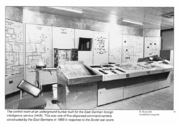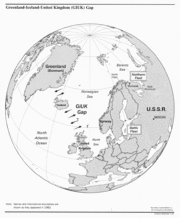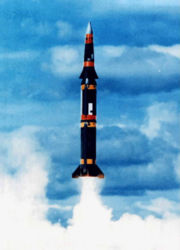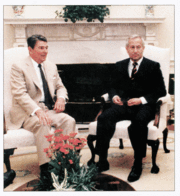Able Archer 83
2007 Schools Wikipedia Selection. Related subjects: Military History and War
Able Archer 83 was a ten-day NATO exercise starting on November 2, 1983 that spanned the continent of Europe and simulated a coordinated nuclear release. It incorporated a new, unique format of coded communication, radio silences, participation by heads of state, and a simulated DEFCON 1 nuclear alert. The realistic nature of the exercise, coupled with deteriorating relations between the United States and the Soviet Union and the anticipated arrival of "super-stealth" Pershing II nuclear missiles in Europe, led some in the USSR to believe that Able Archer 83 was a genuine nuclear strike. In response, the Soviets readied their nuclear forces and placed air units in East Germany and Poland on alert. This relatively obscure incident is considered by many historians to be the closest the world has come to nuclear war since the Cuban Missile Crisis of 1962. The immediate threat of nuclear war abruptly ended with the conclusion of the Able Archer 83 exercise on November 11.
Prelude
Operation RYAN
The event that served as the single greatest catalyst to the Able Archer war scare occurred more than two years earlier, during a May 1981 closed-session meeting of KGB officers. At this meeting, General Secretary Leonid Brezhnev and KGB chairman Yuri Andropov bluntly announced that the United States was preparing a secret nuclear attack on the USSR. To combat this threat, Andropov announced, the KGB and GRU would begin Operation RYAN. RYAN (РЯН) was a Russian acronym for "Nuclear Missile Attack" (Ракетное Ядерное Нападение). Operation RYAN was the largest, most comprehensive peacetime intelligence gathering operation in Soviet history. Agents abroad were charged with monitoring the figures who would decide to launch a nuclear attack, the service and technical personnel who would implement the attack, and the facilities from which the attack would originate. In all probability, the unlikely goal of Operation RYAN was to discover the first intent of a nuclear attack and prevent it.
The impetus for the implementation of Operation RYAN is still largely unknown. Oleg Gordievsky, the highest-ranking KGB official ever to defect, suspected that it was born of the increased "Soviet Paranoia" coupled with "Reaganite Rhetoric". Gordievsky conjectured that Brezhnev and Andropov, who "were very, very old-fashioned and easily influenced ... by Communist dogmas," truly believed that an antagonistic Reagan would push the nuclear button and relegate the Soviet Union to the "ash-heap of history". CIA historian Benjamin B. Fischer lists several concrete occurrences that likely led to the birth of RYAN. The first of these was the use of psychological operations or PSYOP that began soon after President Ronald Reagan took office.
PSYOP
Psychological operations began mid-February 1981 and continued intermittently through 1983. These included a series of clandestine naval operations that stealthily accessed waters near the Greenland-Iceland-United Kingdom GIUK gap, and the Barents, Norwegian, Black, and Baltic seas, demonstrating the extreme proximity NATO ships could attain to critical Soviet military bases. American bombers also flew directly towards Soviet airspace, peeling off at the last moment, occasionally several times per week. These penetrations were designed to test Soviet radar vulnerability as well as demonstrate US capabilities in a nuclear war.
| It really got to them," recalls Dr. William Schneider, [former] undersecretary of state for military assistance and technology, who saw classified "after-action reports" that indicated U.S. flight activity. "They didn't know what it all meant. A squadron would fly straight at Soviet airspace, and other radars would light up and units would go on alert. Then at the last minute the squadron would peel off and return home. |
KAL 007
In contrast to the extremely secretive PSYOPs against the Soviet Union, the Soviet Union's attack on the Korean civilian airliner KAL 007, on September 1, 1983, brought relations between the two superpowers to a very public new low. In addition to illustrating the historically antagonistic relations between the USA and USSR in the early 1980s, the Soviet attack on KAL 007 lends several insights into Able Archer 83. First, the Soviet Union (perhaps due to PSYOP penetrations) guarded its territorial airspace strongly. Second, Soviet satellite systems were ineffective; they could not differentiate between a civilian and military aircraft, nor detect and prevent an American nuclear strike. Finally, the disaster demonstrated the hair-trigger mindset held by many in the Soviet Union. Reagan assessed in his memoirs, "If, as some people speculated, the Soviet pilots simply mistook the airliner for a military plane, what kind of imagination did it take to think of a Soviet military man with his finger close to a nuclear push button making an even more tragic mistake?"
Weapons buildup
On March 23, 1983, Reagan proposed the Strategic Defense Initiative, labeled by the media and critics as "Star Wars". While Reagan viewed the initiative as a safety net against nuclear war, leaders in the Soviet Union viewed it as a definitive departure from the relative weapons parity of Detente and an escalation of the arms race into space. General Secretary Andropov lambasted Reagan for "inventing new plans on how to unleash a nuclear war in the best way, with the hope of winning it."
Despite the enormous Soviet outcry over the "Star Wars" program, the weapons plan that generated the most danger during Able Archer 83 was the 1979 NATO approval and subsequent deployment of intermediate-range Pershing II missiles in Western Europe. These missiles, deployed to counter Soviet SS-20 intermediate-range missiles on its own western border, represented a major threat to the Soviets. The Pershing II was capable of destroying Soviet "hard targets" such as underground missile silos and command and control bunkers. The missiles also possessed "super sudden first strike capability"; it was estimated that the missiles (deployed in West Germany) could reach targets in the Soviet Union within four to six minutes of their launch. These capabilities led Soviet leaders to believe that the only way to survive a Pershing II strike was to preempt it. This fear of an undetected Pershing II attack, according to CIA historian Benjamin B. Fischer, was explicitly linked to the mandate of Operation RYAN: to detect a decision by the United States to launch a nuclear attack and (it must be believed) to preempt it.
Exercise Able Archer 83
Thus, on 2 November 1983, as Soviet intelligence services were attempting to detect the signs of a nuclear strike, NATO began to simulate one. The exercise, codenamed Able Archer, spanned Europe and simulated European command and communications procedures during a nuclear war. It probably emulated the Pentagon’s Single Integrated Operational Plan (SIOP), which, at the time, named 25,000 military targets, 15,000 industrial targets, and 500 targets associated with Soviet leadership. Some Soviet leadership, because of the preceding world events and the exercise’s particularly realistic nature, believed — in accordance with Soviet military doctrine — that the exercise may have been a cover for an actual attack. Indeed, a KGB telegram of 17 February described one likely scenario as such:
| In view of the fact that the measures involved in State Orange [a nuclear attack within 36 hours] have to be carried out with the utmost secrecy (under the guise of maneuvers, training etc) in the shortest possible time, without disclosing the content of operational plans, it is highly probable that the battle alarm system may be used to prepare a surprise RYAN [nuclear attack] in peacetime. |
The 17 February 1983 KGB Permanent Operational Assignment assigned its agents to monitor several possible indicators of a nuclear attack. These included actions by "A cadre of people associated with preparing and implementing decision about RYAN, and also a group of people, including service and technical personnel ... those working in the operating services of installations connected with processing and implementing the decision about RYAN, and communication staff involved in the operation and interaction of these installations."
Because Able Archer 83 simulated an actual release, it is likely that the service and technical personnel mentioned in the memo were active in the exercise. More conspicuously, British Prime Minister Margaret Thatcher and German Chancellor Helmut Kohl participated (though not concurrently) in the nuclear drill. President Reagan, Vice President George H.W. Bush, and Secretary of Defense Casper Weinberger were also intended to participate. Fortunately, Robert McFarlane, who had assumed the position of National Security Advisor just two weeks earlier, realized the implications of such participation early in the exercise’s planning and rejected it.
Another illusory indicator likely noticed by Soviet analysts was an influx of ciphered communications between Great Britain and the United States. Soviet intelligence was informed that "so-called nuclear consultations in NATO are probably one of the stages of immediate preparation by the adversary for RYAN." To the Soviet analysts, this burst of secret communications between the United States and Great Britain one month before the beginning of Able Archer may have appeared to be this "consultation". In reality, the burst of communication regarded the US invasion of Grenada, which caused a great deal of diplomatic traffic as the nominal sovereign of the island was Queen Elizabeth II.
A further startling aspect reported by KGB agents regarded the NATO communications used during the exercise. According to the Moscow Centre's 17 February 1983 memo,
| It [was] of the highest importance to keep a watch on the functioning of communications networks and systems since through them information is passed about the adversary’s intentions and, above all, about his plans to use nuclear weapons and practical implementation of these. In addition, changes in the method of operating communications systems and the level of manning may in themselves indicate the state of preparation for RYAN. |
Soviet Intelligence appeared to substantiate these suspicions by reporting that NATO was, indeed, using unique, never-before-seen procedures as well as message formats more sophisticated than previous exercises that possibly indicated the proximity of nuclear attack.
Finally, during Able Archer 83 NATO forces simulated a move through all alert phases, from DEFCON 5 to DEFCON 1. While these phases were simulated, alarmist KGB agents mistakenly reported them as actual. According to Soviet intelligence, NATO doctrine stated, "Operational readiness No 1 is declared when there are obvious indications of preparation to begin military operations. It is considered that war is inevitable and may start at any moment."
Upon learning that US nuclear activity mirrored its hypothesized first strike activity, the Moscow Centre sent its residencies a flash telegram on November 8 or 9 (Oleg Gordievsky cannot recall which), incorrectly reporting an alert on American bases and frantically asking for further information regarding an American first strike. The alert precisely coincided with the seven- to ten-day period estimated between NATO’s preliminary decision and an actual strike. This was the peak of the War Scare.
The Soviet Union, believing its only chance of surviving a NATO strike was to preempt it, readied its nuclear arsenal. The CIA reported activity in the Baltic Military District in Czechoslovakia, and it determined that nuclear capable aircraft in Poland and Germany were placed "on high alert status with readying of nuclear strike forces". Former CIA analyst Peter Vincent Pry went further, saying he suspects that the aircraft were merely the tip of the iceberg. He hypothesizes that — in accordance with Soviet military procedure and history — ICBM silos, easily readied and difficult for the United States to detect, were also prepared for a launch.
Soviet fears of the attack ended as the Able Archer exercise finished on 11 November. Upon learning of the Soviet reaction to Able Archer 83 by way of the double agent Oleg Gordievsky, a British MI6 asset, President Reagan commented, "I don’t see how they could believe that — but it’s something to think about."
Soviet reaction
The double agent Oleg Gordievsky, whose highest rank was KGB resident in London, is the only Soviet source ever to have published an account of Able Archer 83. Oleg Kalugin and Yuri Shvets, who were KGB agents in 1983, have published accounts that acknowledge Operation RYAN, but they do not mention Able Archer 83. It is important to note that Gordievsky and other Warsaw Pact intelligence agents were extremely skeptical of a NATO first strike, perhaps because of their proximity and understanding of the West. Still, agents reported what they were ordered to observe, not their estimations of what their observations meant. This critical flaw in the Soviet intelligence system — coined by Gordievsky as the "intelligence cycle" — fed the fear of US nuclear aggression.
No Soviet political figure has publicly acknowledged Able Archer 83. Marshal Sergei Akhromeyev, who at the time was Chief of the main operations directorate of the Soviet General Staff, told Cold War historian Don Orbendorfer that he had never heard of Able Archer. The lack of public Soviet response over Able Archer 83 has led some historians, including Fritz W. Ermarth in his piece, "Observations on the 'War Scare' of 1983 From an Intelligence Perch", to conclude that Able Archer 83 posed no immediate threat to the United States.
American reaction
In May 1984, CIA Russian specialist Fritz W. Ermarth drafted "Implications of Recent Soviet Military-Political Activities", which concluded: "we believe strongly that Soviet actions are not inspired by, and Soviet leaders do not perceive, a genuine danger of imminent conflict with the United States." Robert M. Gates, Deputy Director for Intelligence during Able Archer 83, has published thoughts on the exercise that refute this conclusion:
| Information about the peculiar and remarkably skewed frame of mind of the Soviet leaders during those times that has emerged since the collapse of the Soviet Union makes me think there is a good chance — with all of the other events in 1983 — that they really felt a NATO attack was at least possible and that they took a number of measures to enhance their military readiness short of mobilization. After going through the experience at the time, then through the postmortems, and now through the documents, I don’t think the Soviets were crying wolf. They may not have believed a NATO attack was imminent in November 1983, but they did seem to believe that the situation was very dangerous. And US intelligence [SNIE 11-9-84 and SNIE 11-10-84] had failed to grasp the true extent of their anxiety. |
A still-classified report written by Nina Steward for the President’s Foreign Advisory Board concurs with Gates and refutes the previous CIA reports, concluding that further analysis shows that the Soviets were, in fact, genuinely fearful of US aggression.
Some historians, including Beth B. Fischer in her book The Reagan Reversal, pin Able Archer 83 as profoundly affecting President Reagan and his turn from a policy of Confrontation towards the Soviet Union to a policy of Rapprochement. While somewhat cryptic, the thoughts of Reagan and those around him provide important insight upon the nuclear scare and its subsequent ripples. On 10 October 1983, just over a month before Able Archer 83, President Reagan screened a film about Lawrence, Kansas being destroyed by a nuclear attack entitled The Day After. In his diary, the president wrote that the film "left me greatly depressed."
Later in October, Reagan attended a Pentagon briefing on nuclear war. During his first two years in office, he had refused to take part in such briefings, feeling it irreverent to rehearse a nuclear apocalypse; finally, he consented to the Pentagon official’s requests. According to officials present, the briefing "chastened" Reagan. Weinberg said, "[Reagan] had a very deep revulsion to the whole idea of nuclear weapons ... These war games brought home to anybody the fantastically horrible events that would surround such a scenario." Reagan described the briefing in his own words: "A most sobering experience with Cap W and Gen. Vessey in the Situation room, a briefing on our complete plan in the event of a nuclear attack."
These two glimpses of nuclear war primed Reagan for Able Archer 83, giving him a very specific picture of what would occur had the situation further developed. After receiving intelligence reports from sources including Gordievsky, it was clear that the Soviets were unnerved. While officials were concerned with the Soviet panic, they were hesitant about believing the proximity of a Soviet attack. Secretary of State George P. Shultz thought it "incredible, at least to us" that the Soviets would believe the US would launch a genuine attack. In general, Reagan did not share the secretary's belief that cooler heads would prevail, writing:
| We had many contingency plans for responding to a nuclear attack. But everything would happen so fast that I wondered how much planning or reason could be applied in such a crisis... Six minutes to decide how to respond to a blip on a radar scope and decide whether to unleash Armageddon! How could anyone apply reason at a time like that? |
According to McFarlane, the president responded with "genuine anxiety", in disbelief that his leadership could have led to an armed attack. A still-classified 1990 retroactive analysis shows the President’s more alarmed reaction to be more correct than the more relaxed view of some of his staff. To the ailing Politburo — led from the deathbed of the terminally ill Andropov, a man with no firsthand knowledge of the United States, and the creator of Operation RYAN — it seemed "that the United States was preparing to launch... a sudden nuclear attack on the Soviet Union." In his memoirs, Reagan, without specifically mentioning Able Archer 83 — he states earlier that he cannot mention classified information — wrote of a 1983 realization:
| Three years had taught me something surprising about the Russians: Many people at the top of the Soviet hierarchy were genuinely afraid of America and Americans. Perhaps this shouldn't have surprised me, but it did... |
Aftermath
Able Archer 83 was the last nuclear scare of the cold war. By 1983 the United States, under the leadership of President Ronald Reagan, was in the middle of a massive arms build up, one which would last throughout the mid and later half of the 1980s. United States policies of the 1980s, such as the 600-ship Navy, drove home the US desire to continue opposition to the Soviet Union by any means necessary. In the Soviet Union the declining health of then General Secretary Konstantin Chernenko led to the rise of Mikhail Gorbachev in 1985. Gorbachev’s policies and programs within the Soviet Union — notably Glasnost and Perestroika — set into motion the events that ultimately led to its dissolution in 1991.




